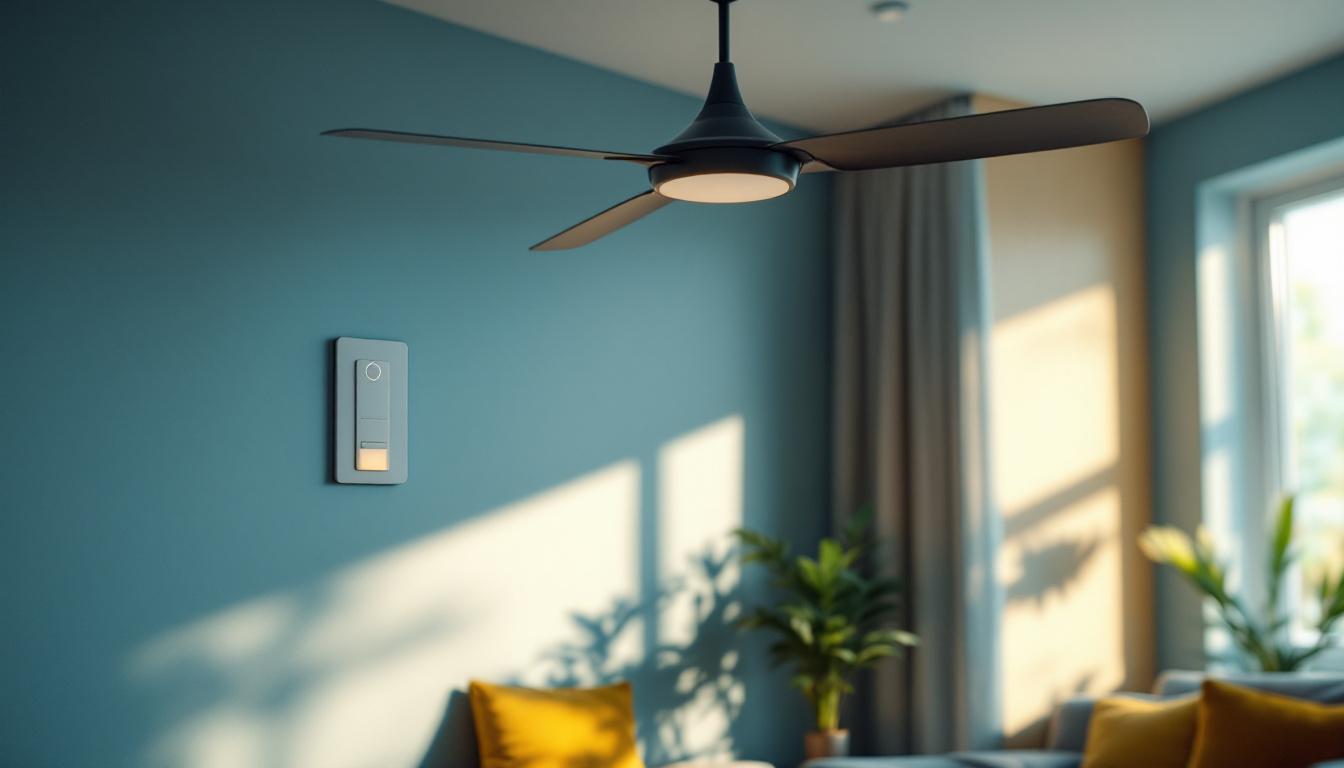
As the demand for energy-efficient solutions continues to rise, ceiling fans with wall control systems have become increasingly popular among homeowners. For lighting contractors, understanding the intricacies of these systems is crucial for successful installations. This article will explore the do’s and don’ts of working with ceiling fans that feature wall controls, ensuring that contractors can deliver quality service while avoiding common pitfalls.
Ceiling fans equipped with wall controls offer numerous advantages that enhance both functionality and aesthetics. These systems provide homeowners with the convenience of adjusting fan speeds and lighting from a fixed location, eliminating the need for remote controls or pull chains. This ease of use is particularly beneficial for those with mobility issues or for rooms with high ceilings. Additionally, wall-mounted controls can be designed to blend seamlessly with the room’s decor, offering a sleek and modern look that complements various interior styles.
Furthermore, wall controls can integrate with smart home systems, allowing for greater automation and energy management. By connecting ceiling fans to smart devices, homeowners can optimize their indoor climate while reducing energy consumption, which is a significant selling point for contractors. With the ability to schedule fan operation or control it remotely via smartphone apps, homeowners can ensure their spaces are always comfortable and energy-efficient, even when they are not at home.
One of the primary benefits of wall controls is the enhanced user experience they provide. Homeowners appreciate the ability to control their ceiling fans and lights from a single switch, which can simplify the operation of multiple fixtures. This convenience can lead to increased customer satisfaction and repeat business for contractors. Moreover, wall controls often come with intuitive designs that allow users to easily identify functions at a glance, making it user-friendly for individuals of all ages. The tactile feedback of a wall switch can also provide a more satisfying experience compared to remote controls that can be misplaced or require batteries.
Energy efficiency is a key consideration for many homeowners. Ceiling fans can help circulate air, reducing the need for air conditioning during warmer months. When paired with wall controls, users can easily adjust fan settings to maximize comfort while minimizing energy costs. This aspect is particularly appealing in eco-conscious markets. Additionally, many modern ceiling fans are designed with energy-efficient motors and LED lighting, further enhancing their sustainability credentials. By choosing ceiling fans with wall controls, homeowners not only enjoy immediate comfort but also contribute to long-term energy savings, making it a wise investment for the future.
Moreover, the strategic placement of ceiling fans can significantly impact energy efficiency. For instance, in winter months, reversing the fan direction can help distribute warm air that rises to the ceiling, thereby reducing heating costs. Wall controls make it easy to switch between modes, allowing homeowners to adapt their ceiling fans to seasonal changes effortlessly. This versatility not only promotes comfort but also encourages a more sustainable lifestyle, aligning with the growing trend of environmentally responsible home improvements.
When it comes to installing ceiling fans with wall controls, there are several best practices that lighting contractors should follow. Adhering to these do’s can help ensure a smooth installation process and a satisfied customer.
Before beginning any installation, it is essential to understand the wiring requirements for ceiling fans with wall controls. These systems often require specific wiring configurations, including a separate wire for the fan and light. Familiarizing oneself with the electrical codes and manufacturer specifications is crucial to avoid any complications during installation.
Contractors should also ensure that the circuit can handle the load of both the fan and the light fixture. Overloading a circuit can lead to tripped breakers or even electrical fires, making it imperative to assess the existing wiring before proceeding. Additionally, it may be beneficial to use a voltage tester to confirm that the power is off before starting the installation, ensuring a safe working environment. Understanding the nuances of wiring can also lead to more efficient troubleshooting in the future, should any issues arise.
After installation, testing the functionality of the wall control is a must. This step ensures that both the fan and light operate as intended. Testing should include checking all speed settings and dimming capabilities, if applicable. A thorough check can help identify any issues early on, allowing for prompt resolution and minimizing callbacks. It’s also wise to verify that the wall control is securely mounted and that all connections are tight, as loose connections can lead to intermittent functionality.
Once the installation is complete, take the time to educate the homeowner about the new system. Explain how to use the wall control effectively, including any unique features or settings. Providing this information empowers homeowners to make the most of their ceiling fan and lighting system, leading to greater satisfaction and fewer troubleshooting calls. Consider providing a printed guide or a quick reference card that outlines how to adjust the fan speed, change the light settings, and troubleshoot common issues. This small gesture can enhance the homeowner’s experience and foster trust in your expertise.
Moreover, it may be beneficial to discuss the energy efficiency of ceiling fans and how they can contribute to lower electricity bills when used correctly. Highlighting the importance of regular maintenance, such as cleaning the fan blades and checking for any signs of wear, can also encourage homeowners to take an active role in the upkeep of their new installation. This proactive approach not only helps in maintaining the functionality of the fan but also extends its lifespan, ensuring that the homeowner gets the best value from their investment.
While there are many best practices to follow, there are also common mistakes that lighting contractors should avoid when working with ceiling fans and wall controls. Recognizing these pitfalls can save time and resources while ensuring a quality installation.
Ignoring local electrical codes and regulations can have serious consequences. Each area may have specific requirements regarding ceiling fan installations, including safety standards and wiring practices. Failing to comply with these regulations can result in fines, legal issues, or even unsafe installations.
Contractors should always stay informed about local codes and ensure that their work meets or exceeds these standards. This diligence not only protects the contractor but also ensures the safety of the homeowner.
Rushing through the installation process can lead to mistakes and oversights. Each step, from wiring to mounting the fan, requires careful attention to detail. Taking the time to double-check connections and ensure proper alignment is essential for a successful installation.
Contractors should also avoid cutting corners to save time. While efficiency is important, the quality of the installation should always be the top priority. A well-installed ceiling fan will perform better and last longer, ultimately benefiting both the contractor and the homeowner.
Aesthetics play a significant role in the overall appeal of a ceiling fan installation. Contractors should consider the style and design of the fan and wall control in relation to the room’s decor. An incongruous design can detract from the overall look of the space and leave homeowners dissatisfied.
When selecting a fan and wall control, it is advisable to discuss options with the homeowner. This collaboration can help ensure that the final product aligns with their vision and enhances the room’s aesthetic appeal.
Even with careful planning and execution, issues can arise during or after the installation of ceiling fans with wall controls. Being prepared to troubleshoot common problems can help contractors address concerns quickly and maintain customer satisfaction.
If the ceiling fan does not operate after installation, the first step is to check the power supply. Ensure that the circuit breaker is not tripped and that the wall control is functioning correctly. If the control is unresponsive, it may need to be replaced or re-wired.
Additionally, verify that all wiring connections are secure and correctly configured. Loose or incorrect connections can prevent the fan from receiving power, leading to operational issues.
Inconsistent fan speed or unusual noises can be signs of installation issues. If a fan is wobbling or making noise, it may not be properly balanced. Ensuring that the fan blades are aligned and securely attached can resolve these issues.
Contractors should also check the wall control settings. If the fan speed is inconsistent, it may be due to a faulty control or incorrect wiring. Testing the fan with a different control can help identify the source of the problem.
Ceiling fans with wall controls present a valuable opportunity for lighting contractors to enhance their service offerings. By understanding the benefits, following best practices, and avoiding common pitfalls, contractors can ensure successful installations that meet customer expectations.
Education and communication with homeowners are key components of a positive experience. By taking the time to explain the features and benefits of ceiling fans with wall controls, contractors can foster trust and satisfaction, leading to repeat business and referrals.
Ultimately, the successful installation of ceiling fans with wall controls hinges on a combination of technical knowledge, attention to detail, and a commitment to quality. By adhering to the do’s and don’ts outlined in this article, lighting contractors can navigate the complexities of these systems with confidence and professionalism.
Ready to elevate your lighting projects with the best in ceiling fans with wall controls? Look no further than LumenWholesale. We provide contractors like you with the highest quality, spec-grade lighting products at prices that can’t be beaten. Our commitment to cutting out the middleman means you enjoy superior products without the extra markups. With our extensive selection that meets rigorous industry standards, you can trust in the reliability and performance of every fan you install. Plus, with free shipping on bulk orders, you can stock up on premium lighting solutions without worrying about hidden costs or complications. Make your next project a shining example of quality, affordability, and convenience. Choose LumenWholesale for Wholesale Lighting at the Best Value.

Discover how exterior flood lights with motion sensors are revolutionizing the work of lighting contractors by enhancing efficiency and security.

Discover how under cabinet light strips are revolutionizing the work of lighting contractors by offering versatile, energy-efficient solutions that enhance both aesthetics and functionality in modern spaces.

Discover how LED light bulb fixtures can revolutionize your lighting projects by enhancing efficiency and reducing costs.

Discover how fluorescent tube sockets are revolutionizing the lighting industry, offering enhanced efficiency and versatility for contractors.